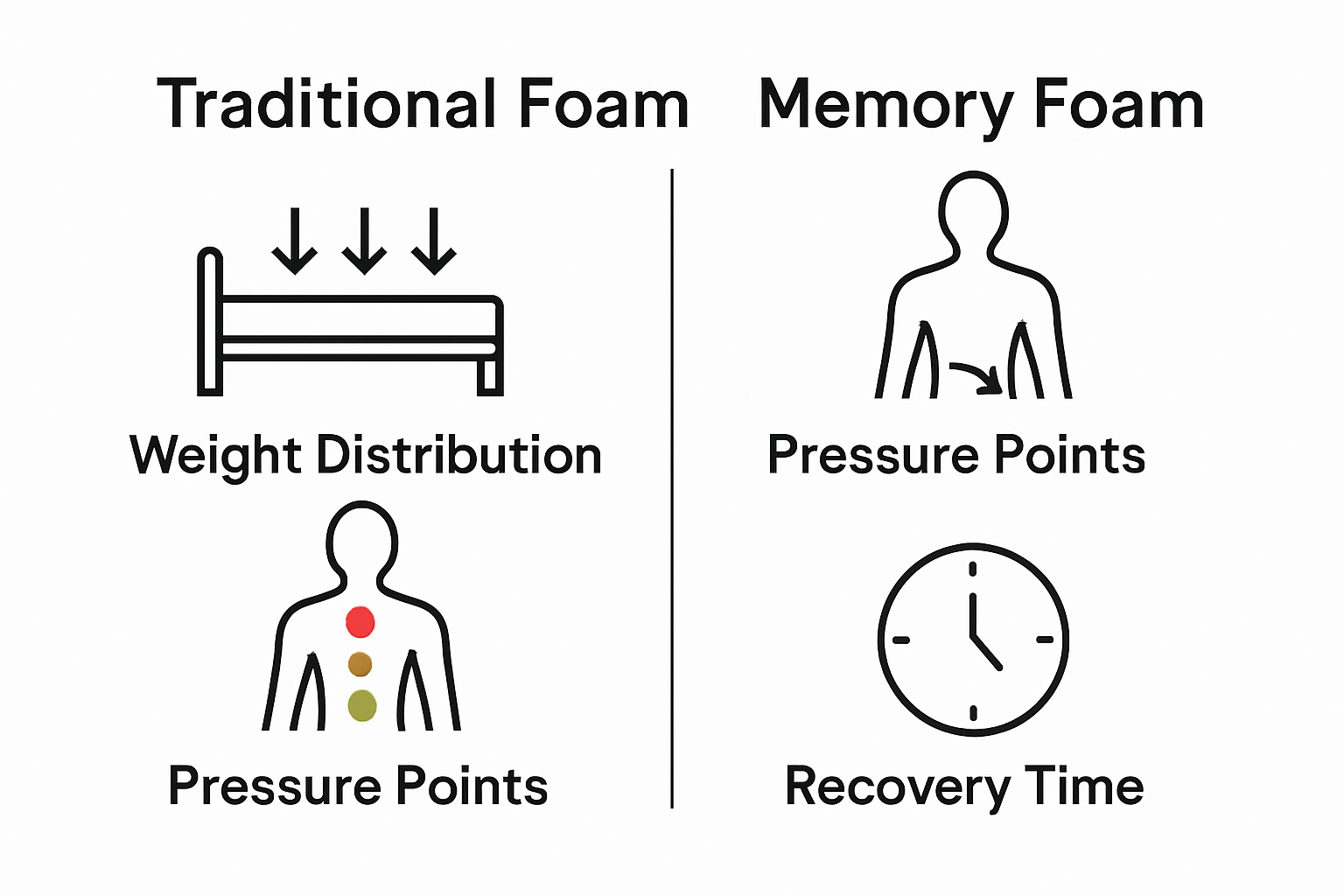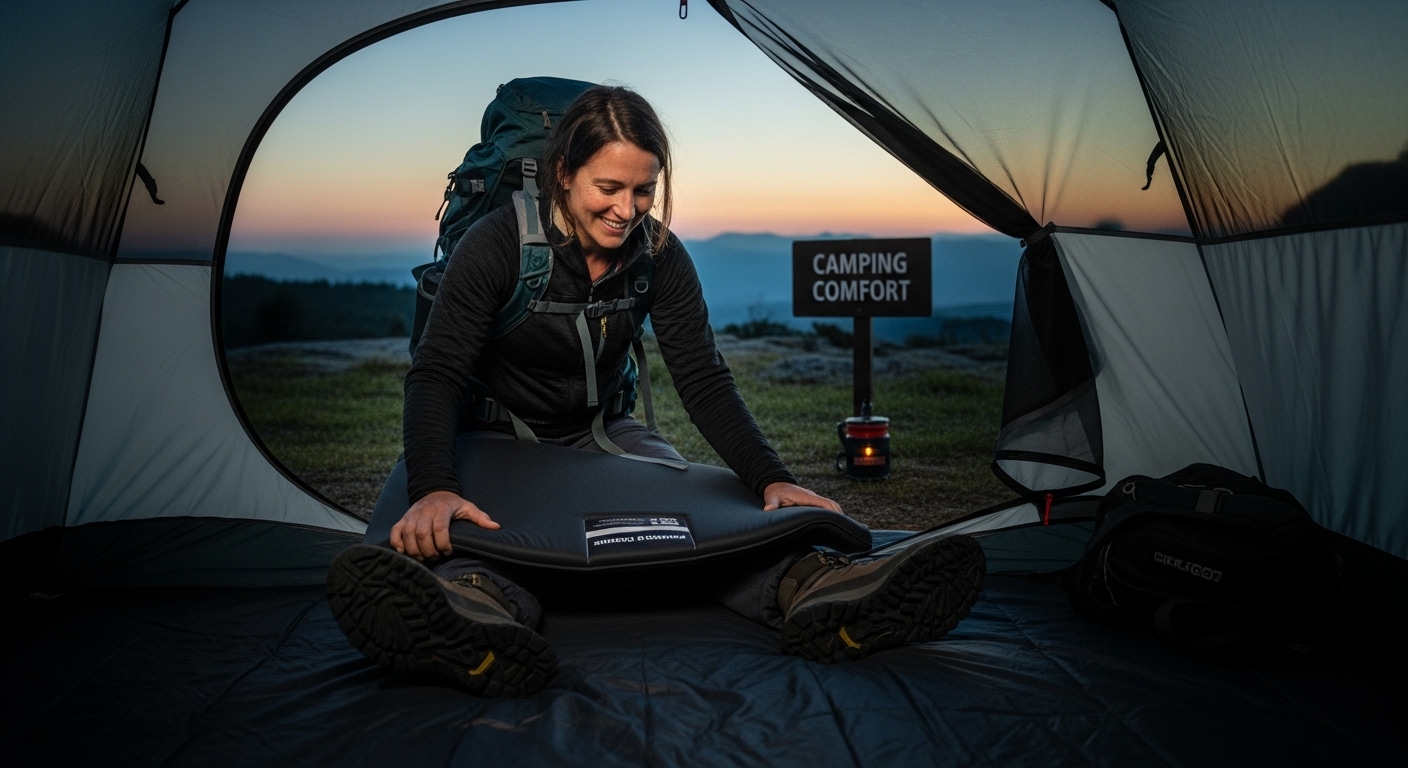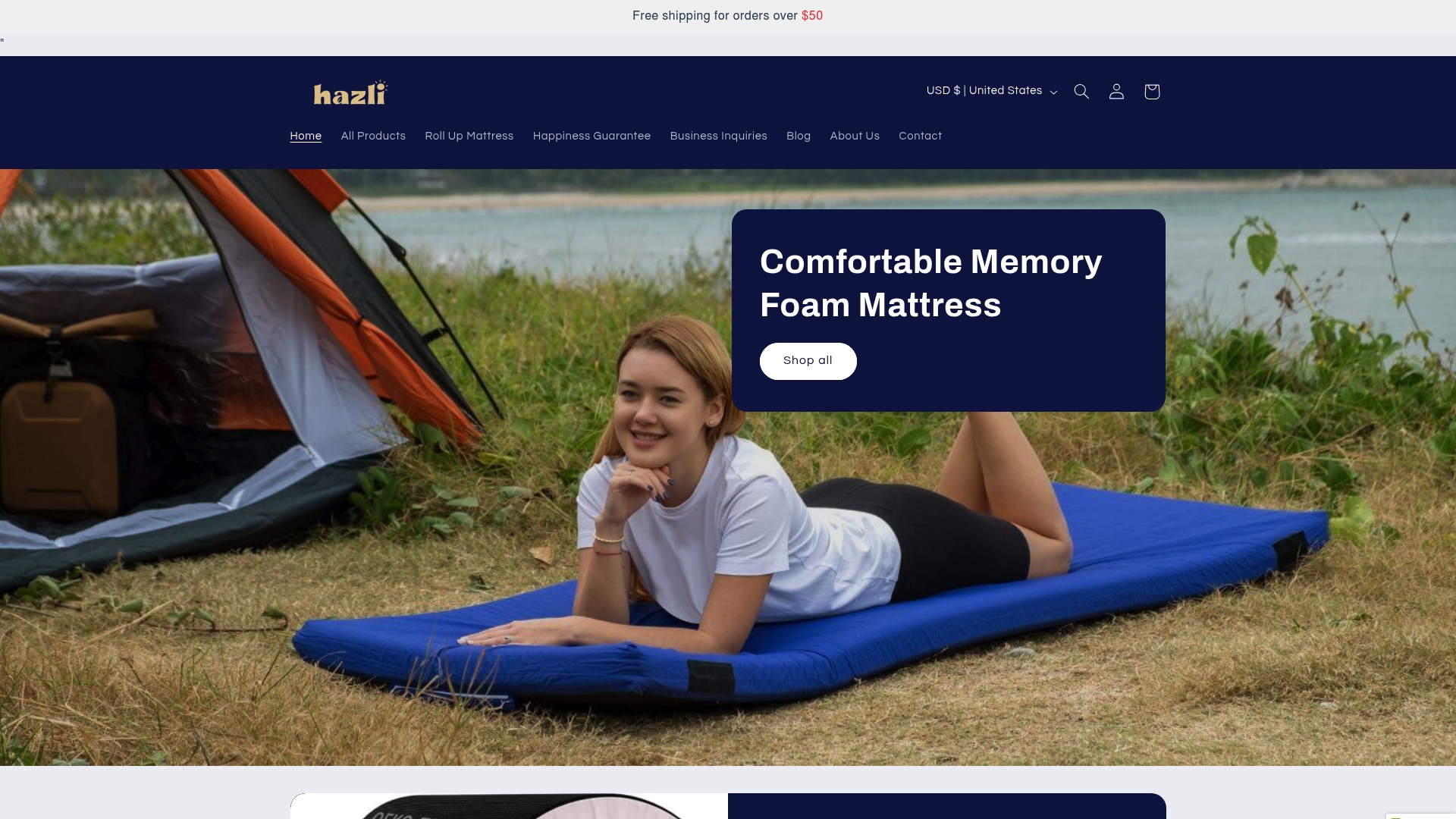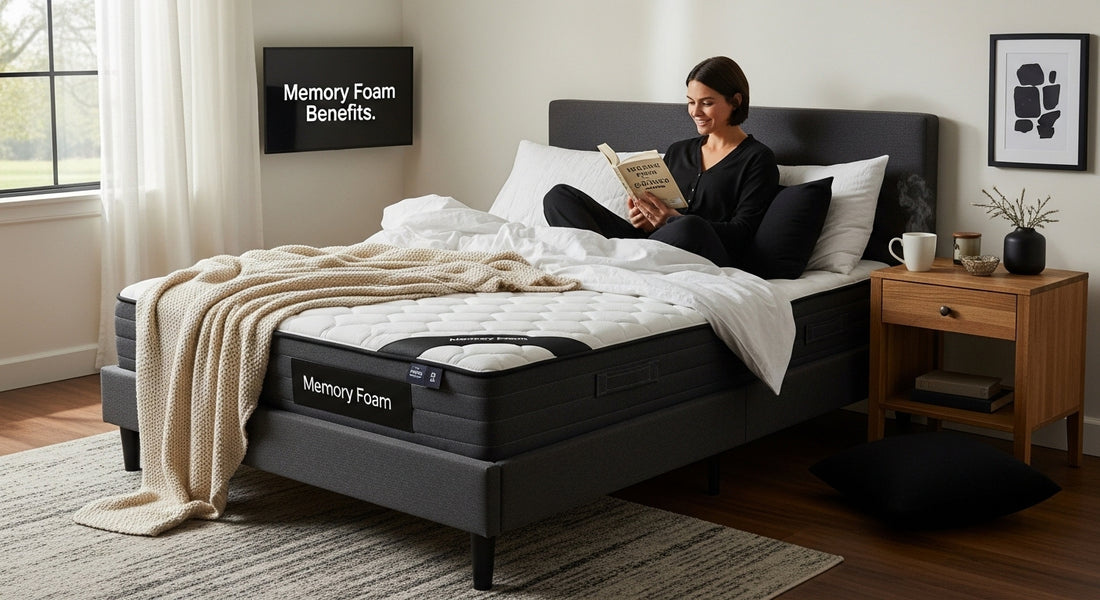Memory foam changed the way we think about comfort. This material was first invented by NASA scientists in the 1960s for astronaut safety and quickly made its way into everyday life. Most people know it for super soft mattresses, but only a few realize that memory foam can reduce pressure points so well it is used in medical equipment and even extreme sports gear. The biggest surprise is how memory foam now powers some of the best outdoor sleeping pads, transforming rough camping nights into real rest in the wild.
Table of Contents
- What Is Memory Foam And Its Origins
- Why Memory Foam Matters For Comfort And Support
- How Memory Foam Works: The Science Behind It
- Key Features And Benefits Of Memory Foam
- Common Uses Of Memory Foam In Outdoor Gear
Quick Summary
| Takeaway | Explanation |
|---|---|
| Memory foam originated in aerospace technology. | Initially developed by NASA to enhance comfort and safety in aircraft, showcasing its advanced material properties. |
| It adapts to body shape and temperature. | Memory foam responds to weight and heat, providing personalized support that relieves pressure points effectively. |
| Key benefits include pressure relief and support. | The material minimizes joint strain and promotes spinal alignment, enhancing overall sleep quality. |
| Durable and long-lasting performance. | Memory foam maintains its shape and support over time, making it an excellent investment for consumers. |
| Widely used in outdoor gear and camping equipment. | Its properties enhance comfort for outdoor enthusiasts, making it suitable for sleeping pads and protective gear. |
What is Memory Foam and Its Origins
Memory foam represents an innovative material with a fascinating technological history, originally engineered for sophisticated aerospace applications. First developed by NASA’s Ames Research Center during the 1960s, this unique polyurethane-based substance was initially designed to improve aircraft seat safety and passenger comfort during high-stress flight conditions.
The Science Behind Memory Foam
At its core, memory foam is a viscoelastic material characterized by its extraordinary ability to conform and respond to temperature and pressure. Unlike traditional foam, memory foam contains special polymers that enable it to temporarily modify its shape when weight or heat is applied, then gradually return to its original form once pressure is removed. This remarkable characteristic allows the material to distribute body weight evenly and provide exceptional pressure relief.

Key properties of memory foam include:
- Temperature sensitivity that allows shape adaptation
- Slow recovery time after pressure is released
- Ability to mold precisely to body contours
- Reduced motion transfer between surfaces
From NASA Innovation to Everyday Comfort
After its initial aerospace development, memory foam transitioned from a highly specialized material to a widely used consumer product. Medical professionals quickly recognized its potential for pressure wound prevention and orthopedic applications. By the 1980s, memory foam began appearing in mattresses, pillows, and medical equipment, revolutionizing comfort and support technologies.
Today, memory foam is ubiquitous across multiple industries, providing enhanced comfort and support in everything from bedding and furniture to athletic equipment and therapeutic devices. Its journey from a NASA research project to a global comfort solution demonstrates the incredible potential of innovative material science.
Why Memory Foam Matters for Comfort and Support
Memory foam has transformed how we experience comfort in various settings, offering unparalleled support and pressure distribution that traditional materials cannot match. Its unique properties make it a game changer for individuals seeking enhanced physical comfort and improved sleep quality.
Understanding Pressure Relief Mechanisms
The core advantage of memory foam lies in its exceptional ability to redistribute body weight uniformly. According to Sleep Foundation research, this material adapts to individual body contours, creating a personalized support system that alleviates pressure points and reduces physical stress.
Key benefits of memory foam’s pressure relief include:
- Minimizing joint and muscle strain
- Promoting proper spinal alignment
- Reducing tossing and turning during sleep
- Preventing pressure ulcers for individuals with limited mobility
Adaptive Support for Different Body Types
Unlike rigid traditional mattresses, memory foam dynamically responds to individual body weight, temperature, and shape. This adaptability means the material provides targeted support, accommodating various body types and sleeping positions. Whether you are a side sleeper, back sleeper, or have specific orthopedic needs, memory foam can adjust to provide optimal comfort.
For outdoor enthusiasts and campers, this translates to superior comfort during rest periods, ensuring recovery and relaxation after physically demanding activities. The material’s ability to conform to the body helps reduce muscle fatigue and supports natural recovery processes.
The technology’s versatility extends beyond sleep surfaces, finding applications in medical equipment, athletic gear, and therapeutic devices. Its capacity to provide personalized support makes memory foam a revolutionary material that prioritizes individual physical comfort and well-being.
How Memory Foam Works: The Science Behind It
Memory foam operates through a sophisticated molecular structure that enables remarkable responsiveness and adaptive capabilities.
Its complex scientific design allows the material to transform how we experience comfort and support across multiple applications.
Molecular Structure and Viscoelasticity
At its fundamental level, memory foam is composed of polyurethane polymers with additional chemical compounds that dramatically enhance its viscosity and density. According to Scientific Materials Research, these specialized polymers create a unique molecular network that responds dynamically to temperature and pressure.
Key molecular characteristics include:
- Open cell structure allowing precise weight distribution
- Temperature-sensitive polymer chains
- Ability to slowly return to original shape after pressure
- Energy absorption and redistribution capabilities
Temperature and Pressure Sensitivity
The extraordinary behavior of memory foam emerges from its viscoelastic properties. When body heat and weight are applied, the foam’s polymer chains temporarily soften and shift, creating a custom-molded surface that precisely matches individual body contours. This means the material can transform from a relatively firm state to a malleable, supportive structure within moments of contact.
For outdoor enthusiasts and campers, this translates into exceptional comfort in varied environmental conditions. Whether experiencing cold mountain nights or warm desert evenings, memory foam adapts, providing consistent support and cushioning. The material’s ability to respond to both temperature and weight makes it an ideal solution for portable bedding and camping equipment that must perform across diverse settings.
Memory foam’s scientific design represents a remarkable fusion of material engineering and human-centered design, offering a solution that goes far beyond traditional cushioning materials. Its molecular intelligence continues to revolutionize comfort across multiple industries, from healthcare to outdoor recreation.
Key Features and Benefits of Memory Foam
Memory foam stands out as a revolutionary material that delivers exceptional performance across multiple dimensions, offering unique advantages that distinguish it from traditional cushioning materials. Its sophisticated design provides users with comprehensive comfort and support solutions.
Adaptive Comfort and Support
The primary hallmark of memory foam is its extraordinary ability to conform precisely to individual body contours. According to Clinical Materials Research, this material can redistribute pressure dynamically, creating a personalized support experience that traditional materials cannot replicate.
Key performance features include:
- Precise body weight distribution
- Immediate pressure point relief
- Customized support for different body types
- Minimal motion transfer between sleeping partners
Durability and Long-Term Performance
Memory foam’s resilient molecular structure ensures consistent performance over extended periods. Unlike traditional foam materials that quickly compress and lose support, memory foam maintains its core structural integrity, providing reliable comfort for years. This durability makes it an excellent investment for outdoor enthusiasts who require reliable equipment that withstands varied environmental conditions.
For campers and travelers, memory foam offers additional benefits beyond standard comfort. Its ability to maintain shape in different temperatures and environments means users can expect consistent support whether camping in cool mountain regions or warm coastal areas. The material’s adaptability ensures comfort remains uncompromised across diverse settings, making it an ideal choice for portable bedding and outdoor sleeping solutions.
The following table summarizes the key features and benefits of memory foam discussed in the article to help readers quickly scan its most important comfort and support attributes.
| Feature or Benefit | Description |
|---|---|
| Pressure Relief | Redistributes body weight to minimize strain and promote proper spinal alignment |
| Adaptive Support | Conforms to different body types and sleeping positions for personalized comfort |
| Temperature Sensitivity | Responds to body heat, softening to improve fit and support in varying environments |
| Durability and Longevity | Maintains core shape and support over time, resisting compression and premature wear |
| Minimal Motion Transfer | Limits movement from one side of a bed or pad to the other, reducing disruption |
| Versatility in Use | Suitable for medical, home, and outdoor gear across multiple industries |
| Shock Absorption | Absorbs and redistributes impact forces in protective gear and athletic equipment |

Memory foam represents more than just a material it is a sophisticated comfort technology that prioritizes individual physical well-being through intelligent design and responsive performance.
Common Uses of Memory Foam in Outdoor Gear
Memory foam has revolutionized outdoor equipment design, offering unprecedented comfort and support across various recreational and adventure applications. Its unique properties make it an ideal material for gear that demands exceptional performance in challenging environments.
Sleeping and Camping Equipment
For outdoor enthusiasts, memory foam transforms sleeping experiences in rugged conditions. Portable sleeping pads and camping mattresses constructed with memory foam provide superior insulation and comfort, adapting to uneven terrain and varying temperatures. According to Sports Science Research, these innovative products distribute body weight evenly, reducing pressure points and minimizing physical strain during extended outdoor stays.
Key applications in camping gear include:
- Ultralight sleeping pad inserts
- Compact travel mattresses
- Portable cushions for camp chairs
- Ergonomic ground sleeping solutions
Performance and Protective Gear
Beyond sleeping equipment, memory foam has become integral to high-performance outdoor protective gear. Hiking boots, backpack straps, and cycling padding now incorporate memory foam to enhance comfort and reduce potential injury risks. The material’s ability to absorb shock and conform to body contours makes it exceptional for equipment requiring both protection and flexibility.
For outdoor adventurers, memory foam offers critical benefits in gear designed for high-impact activities. Helmet linings, knee and elbow protection, and specialized sports equipment leverage memory foam’s shock-absorbing capabilities. Its capacity to distribute impact forces provides an additional layer of safety without compromising mobility or comfort.
The versatility of memory foam continues to expand the boundaries of outdoor equipment design, offering innovative solutions that prioritize user comfort and performance in the most demanding environments.
This table organizes common uses of memory foam in outdoor gear, highlighting the different gear types and the specific advantages memory foam provides for each application.
| Category | Example Gear | Memory Foam Advantage |
|---|---|---|
| Sleeping and Camping | Sleeping pads, travel mattresses | Even weight distribution, pressure relief, insulation on rough terrain |
| Camp Comfort | Camp chair cushions | Enhanced cushioning, body contouring support |
| Performance Footwear | Hiking boots, shoe insoles | Shock absorption, reduced fatigue, improved comfort |
| Load-Bearing Equipment | Backpack straps | Pressure reduction, adaptive fit, less strain during long hikes |
| Protective Sports Gear | Helmet linings, knee pads | Energy absorption, impact protection, personalized fit |
| Recreational Equipment | Cycling padding | Vibration dampening, sustained comfort over long rides |
Upgrade Your Outdoor Sleep Experience With Hazli Memory Foam Solutions
Have you ever struggled with restless nights or sore muscles after camping? The article highlights how memory foam’s adaptive support and pressure relief can transform the quality of your rest, whether you’re relaxing after a day hike or recovering from outdoor adventures. Many campers face discomfort when using thin or unsupportive pads, leading to fatigue and disrupted sleep. Hazli Collection addresses these pain points with high-quality memory foam mattresses and gear that prioritize personalized comfort and support in every outdoor setting.

Why settle for rough nights away from home? Discover how our carefully engineered camping mattresses, featured at Hazli Collection, harness the same advanced memory foam technology described in the article to provide consistent comfort, durability, and reliability. If you are ready to elevate your outdoor sleep and experience the true advantages of memory foam, visit our user-friendly site today. Shop now to enjoy a more restful, energized outdoor lifestyle on Hazli Collection.
Frequently Asked Questions
What is memory foam made of?
Memory foam is primarily made from polyurethane, a type of polymer, along with additional chemicals that enhance its viscosity and density, creating a viscoelastic material that responds to temperature and pressure.
How does memory foam provide support and comfort?
Memory foam provides support and comfort by conforming to the body’s contours, redistributing body weight evenly, and relieving pressure points. This helps minimize joint strain and promotes proper spinal alignment.
What are the benefits of using memory foam outdoor gear?
Memory foam in outdoor gear offers exceptional comfort, insulation, and support, adapting to uneven terrain and varying temperatures. It also reduces pressure points, minimizes strain, and enhances overall sleep quality during outdoor activities.
Can memory foam help with pressure ulcers?
Yes, memory foam is often used in medical applications to help prevent pressure ulcers, as its ability to evenly distribute body weight and alleviate pressure points can be beneficial for individuals with limited mobility.

